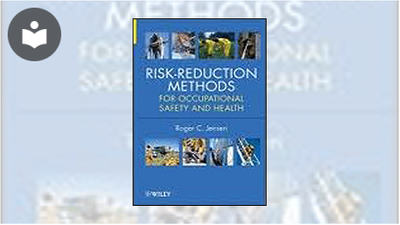Risk Reduction Methods for Occupational Safety and Health
- 7h 38m
- Roger C. Jensen
- John Wiley & Sons (US)
- 2012
Integrating the fields of occupational safety, industrial hygiene, and ergonomics, this text enables readers to anticipate industry hazards and implement tested and proven strategies to avoid, whenever possible, or minimize the harm and damages. The author's innovative systematic approach organizes the thousands of hazard control measures in use today into nine fundamental risk-reduction strategies.
Risk-Reduction Methods for Occupational Safety and Health is organized into five parts:
- Part I, Background, sets forth fundamental principles and defines key terms essential for understanding concepts explored throughout the text
- Part II, Analysis Methods, describes essential system safety tools for occupational safety and health (OSH) professionals
- Part III, Programmatic Methods for Managing Risk, explores common components of OSH programs, synthesizing all risk-reduction tactics into nine core risk-reduction strategies
- Part IV, Risk Reduction for Energy Sources, examines hazards involving kinetic energy, electrical energy, acoustic energy, thermal energy, fires, explosions, pressure, electromagnetic energy, and weather and geological events
- Part V, Risk Reduction for Other Than Energy Sources, addresses workplace hazards, chemical substances, biologic agents, musculoskeletal stressors, and acts of violence
Throughout Parts IV and V, the author explains how current OSH practices fit within the nine risk-reduction strategies set forth in Part III. End-of-chapter exercises in all chapters help readers apply their newfound skills and knowledge to solving common OSH challenges.
With its unique systematic approach, Risk-Reduction Methods for Occupational Safety and Health is not only recommended as a textbook for OSH students, but also as a reference for OSH professionals around the world, providing them with a new, more streamlined approach to their work.
In this Book
-
Multidisciplinary Perspective
-
Key Terms and Concepts
-
Tools for Analysis and Synthesis
-
Analyzing Jobs and Tasks
-
Using Risk-Assessment Methods
-
Analyzing Failure Modes
-
Constructing Fault Trees
-
Analyzing Fault Trees
-
Incident Investigation Programs
-
Human Error Reduction
-
Risk-Reduction Strategies
-
Common Components of OSH Programs
-
Tools for Managing OSH Programs
-
Kinetic Energy Hazards
-
Electric Energy Hazards
-
Acoustic Energy and Vibration Hazards
-
Thermal Hazards: Heat and Cold
-
Fire Hazards
-
Explosion Hazards
-
Pressure Hazards
-
Hazards of Electromagnetic Energies
-
Hazards of Severe Weather and Geological Events
-
Workplace Conditions
-
Chemical Substances
-
Biological Agents
-
Musculoskeletal Stressors
-
Violent Actions of People



